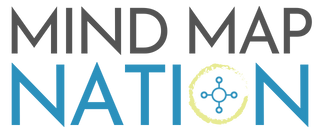When to Use Mind Maps: Turn Chaos to Productivity
Mind mapping is a powerful tool for organizing chaos, but when exactly should we use it?
First, we need to expand the definition of what a “project” is.
Everything we do is a project.
Building a new product for your company is a project, coming up with a business strategy and making a presentation is a project, writing an essay or studying for an exam is a project, planning for your next vacation or even trying to figure out major life decisions are projects. You get the idea.
The anatomy of a project is that it’s got a beginning and end, in between is a process. If you’re making a presentation for work or school, it starts with the objective and your understanding of your audience (the why) and the end is the deliverable itself: a powerpoint deck and presenting it to your audience.
Project Chaos & Order States
In this way, the lifetime of a project goes from chaos to order over time. Our job is to put in the work to bring chaos into order states.
The problem is that we too often try to skip right to the ordered end result, which causes us a lot of stress. If you’ve ever struggled to put together a PowerPoint presentation without outlining or storyboarding first, then you’ll know what I mean. Also, in reality, projects usually go through multiple cycles of chaos and order as new information comes in. Just look at how a typical tech startup is formed.
The key is to use the right tool at the right time. Mind maps happen to be great at taming chaos events and bringing them back to order.
When to Use Mind Maps
In the Medieval alchemy, there was this fabled philosopher stone that turned common substances like lead and iron into precious metals like gold and platinum. In this way, Mind Maps are like productivity philosopher stones that transition us from creative inputs to productive outputs.
Chaos often gets a bad rap, but it’s where the creativity and possibilities are. If we move too quickly into the Ordered output side, we miss the opportunity to take advantage of all the novel ideas that could’ve been generated.
For example, I’m currently in the early stages of creating a website and community for mind mappers. My initial mind map (meta right?) showed that I didn’t know enough about my users or how to build a community. All arrows pointed to the need learn more by scheduling meetings with people who held the answers to my questions. Any of these meetings could change the trajectory of my project at this early stage, which is super exciting! Furthermore, now that these tasks are surfaced, I can work them into my 2-week sprints in a structured manner.
Mind mapping isn’t a replacement for the other tools (ex: Powerpoint, Kanban boards, design software, etc) that help bring our ideas to concrete outputs, but it is excellent for getting your ideas laid out and organized before taking the next step. In fact, I highly recommend sharing your initial map with others or stakeholders (if you’re working in a team) for feedback before investing more effort in creating the actual thing. This way, the mind map are essentially the blueprint for the project.
📺 For the video folks, here’s the YouTube lesson for more examples of how I turn mind maps into mobile apps, websites, presentations, and the very articles that you read every week in the newsletter.




